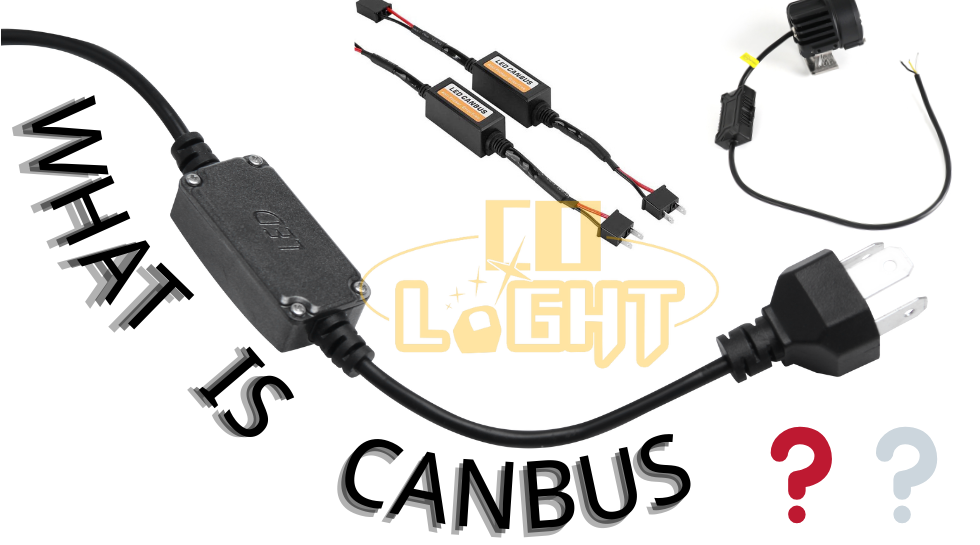En la era actual de continuos avances en la tecnología de iluminación automotriz, muchos propietarios de automóviles optan por actualizar sus faros halógenos tradicionales a faros LED avanzados. Sin embargo, este proceso de actualización puede desencadenar una serie de problemas de compatibilidad, y una solución clave es el uso de CANBUS. El CANBUS juega un papel crucial en la actualización de la iluminación automotriz, abordando no solo la falta de coincidencia entre los sistemas eléctricos, sino también asegurando el correcto funcionamiento de los nuevos faros LED.
En este blog, analizaremos en profundidad el papel de los CANbus, por qué son esenciales para la actualización de la iluminación de los automóviles y cómo se convierten en una solución eficaz para los problemas de compatibilidad. Exploremos los misterios tecnológicos estrechamente relacionados con la iluminación de los vehículos.
¿Qué es Canbus?
El bus CAN , también conocido como bus de red de área del controlador, está diseñado para permitir la comunicación entre microcontroladores y dispositivos en aplicaciones sin un host central. En esencia, el bus CAN verifica el estado operativo de varios componentes de su vehículo. El sistema CANbus determina la funcionalidad de las bombillas midiendo la resistencia en el circuito y las señales de pulso emitidas por las luces. Por eso, cuando reemplaza las bombillas halógenas por LED, el bus CAN puede activar una luz de advertencia debido al menor voltaje de las bombillas LED.
Actualmente, existen tres tipos de decodificadores: de resistencia, de condensador y combinados.
1. Decodificador de resistencias

Las bombillas halógenas tradicionales suelen funcionar a 55 vatios o menos. Los LED son más eficientes energéticamente y requieren solo entre 15 y 35 vatios. Esto hace que el sistema CANbus crea que las luces pueden superar su rango operativo. Las resistencias pueden aumentar el consumo de energía para engañar al CANbus y evitar el parpadeo. Las ventajas de las resistencias incluyen su bajo costo, facilidad de uso y funcionalidad casi garantizada en situaciones comunes. Sin embargo, una desventaja es que las resistencias generan una cantidad significativa de calor. Deben instalarse en componentes metálicos y mantenerse a cierta distancia de las piezas de goma.
Ventajas: Bajo costo, fácil de usar.
Contras: Alta generación de energía, temperatura de funcionamiento elevada.
2. Decodificador de condensadores

En el caso de las bombillas LED para automóviles de alta potencia que funcionan a 45-55 vatios o menos, el parpadeo suele deberse al protocolo de modulación por ancho de pulso del bus CAN. En estos casos, los condensadores pueden reducir los problemas de parpadeo al eliminar las perturbaciones de voltaje. Sin embargo, los condensadores solo son adecuados para determinados módulos de automóviles, lo que puede limitar su eficacia para solucionar el problema.
Ventajas: Reducción de problemas de parpadeo.
Contras: Aplicabilidad limitada a ciertos vehículos, limitaciones sustanciales.
3. Decodificador de combinación

Un decodificador combinado generalmente incluye resistencias, capacitores y una placa de circuito. La placa de circuito está diseñada para detectar protocolos CANbus, lo que permite una experiencia plug-and-play. Este tipo de decodificador puede solucionar casi el 90 % de los problemas de parpadeo. Es fácil de usar, proporciona una retroalimentación de señal similar a las bombillas halógenas, genera poco calor, detecta pulsos de la computadora del vehículo, garantiza una salida de energía estable y presenta menos riesgos de seguridad.
Ventajas: Plug-and-play, retroalimentación de señal similar, baja generación de calor, detección de señal de pulso, salida de potencia estable
Contras: Precio más alto
El papel y la importancia del Canbus
¿Cuándo necesitas un bus CAN? Es posible que necesites un bus CAN para tu coche si has instalado faros LED y te encuentras con alguno de los siguientes problemas:- Parpadeo cuando se encienden las bombillas.
- Visualización de errores en los faros.
- Las bombillas permanecen encendidas incluso después de apagarse.
- Salida de luz anormalmente tenue.
Los CAN-Bus de los faros son dispositivos electrónicos diseñados para solucionar problemas de compatibilidad que pueden surgir durante la actualización de algunos sistemas de iluminación LED de automóviles. Estos problemas pueden incluir:
Valores de resistencia no coincidentes: algunos vehículos están diseñados con circuitos de resistencia específicos para detectar si los faros delanteros funcionan correctamente. Los faros delanteros halógenos tradicionales utilizan valores de resistencia más altos, mientras que los faros delanteros LED suelen tener valores de resistencia más bajos. Si los valores de resistencia no coinciden al reemplazar los faros delanteros, el vehículo puede asumir incorrectamente que las bombillas están quemadas, lo que genera parpadeos o advertencias.
Problemas de polaridad inversa: los sistemas eléctricos de algunos vehículos requieren que las bombillas funcionen solo en una dirección específica del flujo de corriente, mientras que los faros LED suelen ser bidireccionales, lo que significa que no tienen polaridad. Esto puede provocar que los faros no se enciendan correctamente o parpadeen.
La función de los decodificadores de faros es solucionar estos problemas de compatibilidad. Simulan los valores de resistencia correctos, ajustan la dirección de la corriente o realizan otras operaciones necesarias para garantizar que los faros LED funcionen correctamente en el vehículo, evitando advertencias o problemas incorrectos. Garantizan el correcto funcionamiento del sistema de faros, eliminando los problemas de compatibilidad que pueden surgir al actualizar a faros LED sin afectar el funcionamiento normal del vehículo. Los decodificadores de faros son esenciales en muchos vehículos que se someten a actualizaciones de faros LED.
Al pedir bombillas o algunas luces de conducción LED en el sitio web de COLIGHT , no hay necesidad de preocuparse ya que la mayoría de los productos vienen con compatibilidad canbus, lo que garantiza una mejor compatibilidad con su vehículo.

